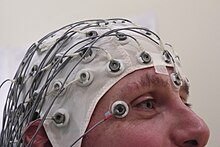
Albert Bandura was a Canadian-American psychologist. He was a professor of social science in psychology at Stanford University.
Uses and gratifications theory is a communication theory that describes the reasons and means by which people seek out media to meet specific needs. The theory postulates that media is a highly available product, that audiences are the consumers of the product, and that audiences choose media to satisfy given needs as well as social and psychological uses, such as knowledge, relaxation, social relationships, and diversion.

The Bobo doll experiment is the collective name for a series of experiments performed by psychologist Albert Bandura to test his social learning theory. Between 1961 and 1963, he studied children's behaviour after watching an adult model act aggressively towards a Bobo doll. The most notable variation of the experiment measured the children's behavior after seeing the adult model rewarded, punished, or experience no consequence for physically abusing the Bobo doll.

Reasons for opposition to pornography include religious objections and feminist concerns, as well as alleged harmful effects, such as pornography addiction. Pornography addiction is not a condition recognized by the DSM-5, or the ICD-11. Anti-pornography movements have allied disparate social activists in opposition to pornography, from social conservatives to harm reduction advocates. The definition of "pornography" varies between countries and movements, and many make distinctions between pornography, which they oppose, and erotica, which they consider acceptable. Sometimes opposition will deem certain forms of pornography more or less harmful, while others draw no such distinctions.
In media studies, mass communication, media psychology, communication theory, and sociology, media influence and themedia effect are topics relating to mass media and media culture's effects on individuals' or audiences' thoughts, attitudes, and behaviors. Through written, televised, or spoken channels, mass media reach large audiences. Mass media's role in shaping modern culture is a central issue for the study of culture.
The study of violence in mass media analyzes the degree of correlation between themes of violence in media sources with real-world aggression and violence over time. Many social scientists support the correlation, however, some scholars argue that media research has methodological problems and that findings are exaggerated. Other scholars have suggested that the correlation exists, but can be unconventional to the current public belief.
Media psychology is the branch and specialty field in psychology that focuses on the interaction of human behavior with media and technology. Media psychology is not limited to mass media or media content; it includes all forms of mediated communication and media technology-related behaviors, such as the use, design, impact, and sharing behaviors. This branch is a relatively new field of study because of advancement in technology. It uses various methods of critical analysis and investigation to develop a working model of a user's perception of media experience. These methods are used for society as a whole and on an individual basis. Media psychologists are able to perform activities that include consulting, design, and production in various media like television, video games, films, and news broadcasting. Media psychologists are not considered to be those who are featured in media, rather than those who research, work or contribute to the field. Mediacology is a new term used as a collaborative word of Media and Psychology.
Social cognitive theory (SCT), used in psychology, education, and communication, holds that portions of an individual's knowledge acquisition can be directly related to observing others within the context of social interactions, experiences, and outside media influences. This theory was advanced by Albert Bandura as an extension of his social learning theory. The theory states that when people observe a model performing a behavior and the consequences of that behavior, they remember the sequence of events and use this information to guide subsequent behaviors. Observing a model can also prompt the viewer to engage in behavior they already learned. Depending on whether people are rewarded or punished for their behavior and the outcome of the behavior, the observer may choose to replicate behavior modeled. Media provides models for a vast array of people in many different environmental settings.
In psychology, desensitization is a treatment or process that diminishes emotional responsiveness to a negative, aversive, or positive stimulus after repeated exposure. Desensitization can also occur when an emotional response is repeatedly evoked when the action tendency associated with the emotion proves irrelevant or unnecessary. The process of desensitization was developed by psychologist Mary Cover Jones and is primarily used to assist individuals in unlearning phobias and anxieties. Desensitization is a psychological process where a response is repeatedly elicited in circumstances where the emotion's propensity for action is irrelevant. Joseph Wolpe (1958) developed a method of a hierarchal list of anxiety-evoking stimuli in order of intensity, which allows individuals to undergo adaptation. Although medication is available for individuals with anxiety, fear, or phobias, empirical evidence supports desensitization with high rates of cure, particularly in clients with depression or schizophrenia. Wolpe's "reciprocal inhibition" desensitization process is based on well-known psychology theories such as Hull's "drive-reduction" theory and Sherrington's concept of "reciprocal inhibition." Individuals are gradually exposed to anxiety triggers while using relaxation techniques to reduce anxiety. It is an effective treatment for anxiety disorders.
Mood management theory posits that the consumption of messages, particularly entertaining messages, is capable of altering prevailing mood states, and that the selection of specific messages for consumption often serves the regulation of mood states. Mood management theory now belongs to a larger group of theoretical approaches which speak on media content and how it plays a role in mood management. Mood optimization is a current affective sate of media mood management.
Moral disengagement is a meaning from Developmental psychology, educational psychology and social psychology for the process of convincing the self that ethical standards do not apply to oneself in a particular context. This is done by separating moral reactions from inhumane conduct and disabling the mechanism of self-condemnation. Thus, moral disengagement involves a process of cognitive re-construing or re-framing of destructive behavior as being morally acceptable without changing the behavior or the moral standards.

Pornography has been defined as any material in varying forms, including texts, video, photos or audio that is consumed for sexual satisfaction and arousal of an individual or partnership. The effects of pornography on individuals or their intimate relationships have been a subject of research.
Reinforcement theory is a limited effects media model applicable within the realm of communication. The theory generally states that people seek out and remember information that provides cognitive support for their pre-existing attitudes and beliefs. The main assumption that guides this theory is that people do not like to be wrong and often feel uncomfortable when their beliefs are challenged.
Excitation-transfer theory, based heavily on psychology, psychophysiology, and biochemistry, is a psychological theory that originated in the field of social psychology and effects studies pertaining to communication. In the context of communication, this theory suggests that the emotional response to a particular message or stimulus can be influenced by the residual, or remaining, arousal from a previous experience. Excitation-transfer theory was first proposed by Dolf Zillmann in the 1970s to explain the emotional and physiological processes involved in the transfer of arousal from one situation to another.
Affective disposition theory (ADT), in its simplest form, states that media and entertainment users make moral judgments about characters in a narrative which in turn affects their enjoyment of the narrative. This theory was first posited by Zillmann and Cantor (1977), and many offshoots have followed in various areas of entertainment. Entertainment users make constant judgments of a character's actions, and these judgments enable the user to determine which character they believe is the "good guy" or the "villain". However, in an article written in 2004, Raney examined the fundamental ADT assumption that viewers of drama always form their dispositions toward characters through moral judgment of motives and conduct. Raney argued that viewers/consumers of entertainment media could form positive dispositions toward characters before any moral scrutinizing occurs. He proposed that viewers sometimes develop story schemas that provide them "with the cognitive pegs upon which to hang their initial interpretations and expectations of characters". The basic idea of the affective disposition theory is used as a way to explain how emotions become part of the entertainment experience.
The frustration–aggression hypothesis, also known as the frustration–aggression–displacement theory, is a theory of aggression proposed by John Dollard, Neal Miller, Leonard Doob, Orval Mowrer, and Robert Sears in 1939, and further developed by Neal Miller in 1941 and Leonard Berkowitz in 1969. The theory says that aggression is the result of blocking, or frustrating, a person's efforts to attain a goal.
Examples of misogyny exist in many published forms, within multiple cultures and well-observed works. Technological advances in the modern era have contributed proficient means to media and marketing to the resultant mass media in the 21st century. The merging of misogyny and mass media has made numerous examples where studies have concluded correlations between misogynous messages, both obvious and subliminal. Corresponding physical appearance of violence and hateful conduct may be seen relative to exposure.
Subliminal stimuli are any sensory stimuli below an individual's threshold for conscious perception, in contrast to supraliminal stimuli.
Jennings Bryant was Distinguished Professor Emeritus at The University of Alabama. Prior to his retirement in 2010, he was Communication and Information Sciences Distinguished Research Professor, holder of the Reagan Endowed Chair of Broadcasting, and Associate Dean for Graduate Studies and Research at UA. Jennings Bryant was married to Sara Poteat Bryant for 43 years. He and Sara were the parents of three children. The Bryants lived on a family farm in the Mountain Valley Rural Agricultural Historical District in Glenwood, North Carolina.
Affect labeling is an implicit emotional regulation strategy that can be simply described as "putting feelings into words". Specifically, it refers to the idea that explicitly labeling one's, typically negative, emotional state results in a reduction of the conscious experience, physiological response, and/or behavior resulting from that emotional state. For example, writing about a negative experience in one's journal may improve one's mood. Some other examples of affect labeling include discussing one's feelings with a therapist, complaining to friends about a negative experience, posting one's feelings on social media or acknowledging the scary aspects of a situation.








